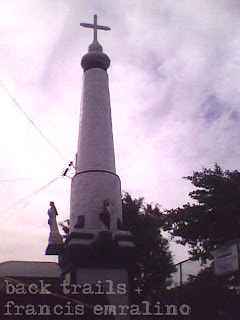Besides the intricately designed retablos and religious items within the Paete church, the paintings hanged on its walls prove to be interesting. Why? Because they are direct relics from Paete’s distant past. I have been to a number of museums before showcasing many precious paintings by eminent Filipino painters but one cannot get near enough to them. But here in Paete you can actually see and touch them for yourself, as if they really are part of the Paeteños’ daily lives.And perhaps that is the problem with these paintings. They are too susceptible for public viewing and abuse that they are threatened by further vandalism. Now what are these paintings I am talking about?


San Cristobal
The first one is entitled San Cristobal (or Saint Christopher). It is a painting done on a 3.5 meter x 5 meter maulawin wood plank by Jose Luciano Dans in 1850. It’s huge already, almost reaching the church’s ceiling. A “curiouser” painting is found just beside this one which is also depiction of San Cristonal. This one has that native look in it: upper torso bared, a bolo (or a kris?), and a tree that looked like a coconut. It is reputed that this was the original San Cristobal painting. But the patrons, probably the church officials, did not like the look and so commissioned a second painting, one which was ‘tamer’ and pleasing to the (conservative) eyes. [I suggest that you read, dear chance reader, stories about St. Christopher. They are quite entertaining.]



Juicio Final
Another one is called Juicio Final done from 1717 to 1720. This one depicts St. Francis and the Salvation of the Soul. The painting must have been of fiery red when it was finished. But time has worn down the colors used for this art work.




 Langit, Lupa at Impiyerno
Langit, Lupa at ImpiyernoAnother Jose Luciano Dans piece. This is quite interesting and close to my heart. The painting is in essence divided into three. The upper part depicts the heaven, with the crucifixion of Christ at the center of attention, moist likely leading the viewer to the thought that he is a ‘God’ who sacrificed himself for the world below.
And this world is given emphasis by two figures in the center of the painting: Adam and Eve standing below the Tree of Knowledge. Right below is hell, easily identified by the suffering faces of the humans painted there. It is good to note that here we can see the sensitivity of the people at that time about the religious teachings. Different punishments were given to the sinners with different transgressions, ones which were probably done during their mortal experience. I have tried to show these ‘specific’ punishments here by taking close-up shots of them.
On Maintaining the Paete Church Paintings
One needs not another earthquake to devastate the church and the treasures inside it. The visible vandalisms on the paintings inside should prompt the church caretakers to make the necessary steps to ensure the safety of these works. A glass protection should do temporarily, if they cannot provide for a more permanent and hassle-free way to preserve them. I admit myself being a historical relic collector but being one would not be good for these paintings. These ones are in the danger of becoming mere souvenirs. You just have to see the San Cristobal and Langit, Lipa at Impyerno paintings to realize how they are being neglected. Again I say they are treasures and we are fortunate enough that we have seen them in our generation. Let us bequeath them for the coming generations.








































